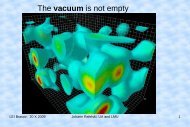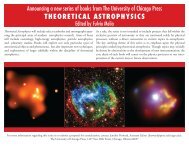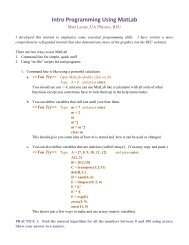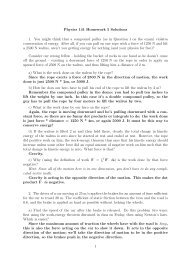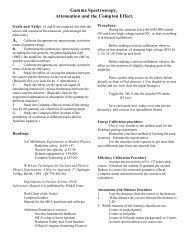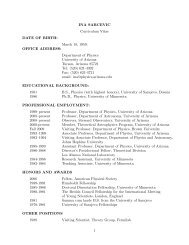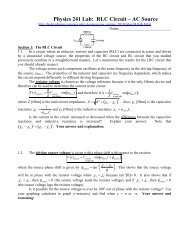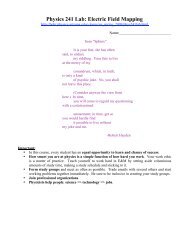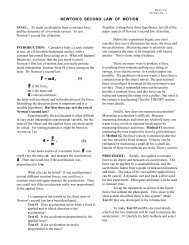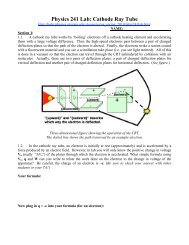Physics 241 Lab: RC Circuits â AC Source
Physics 241 Lab: RC Circuits â AC Source
Physics 241 Lab: RC Circuits â AC Source
Create successful ePaper yourself
Turn your PDF publications into a flip-book with our unique Google optimized e-Paper software.
1.2. The <strong>Source</strong> Voltage Equation: V source(t) V sourcesin( Dt )amplitudeThe source voltage equation is straightforward. It oscillates sinusoidally, i.e. it is a sine functionof time. The maximum voltage applied across the whole circuit is V source. The source oscillates with anamplitudeangular driving frequency D 2f D(which you will set later with your function generator). The sourcevoltage is phase shifted from the resistor voltage by an amount arctan C where X C is the reactive R capacitance of the capacitor given by the equation C 1 (more on this later). Note that this x-like DCvariables are really the capital Greek letter Chi (pronounced kai).If you look at the equation for resistor voltage, you will see no phase shift. Again, what thismeans is that we measure all phases in relation to the resistor not the source. The resistor will have itsmaximum voltage at a different time than when the source voltage is maximum.Imagine a sinusoidally driven <strong>RC</strong> circuit. If the source voltage has an amplitude ofV sourceamplitude=1.8 volts, a linear driving frequency f D =555 Hz, a resistance R=150 , and a capacitance C=1.5x10 -5 F,find the phase shift of the source voltage compared to the resistor. Your work and answer:1.3. The Resistor Voltage Equation: V R(t) R VZsourcesin( Dt)amplitudeThe resistor voltage oscillates sinusoidally without a phase shift while R is simply the resistance.Z is the impedance of the whole circuit. Z acts like the “total resistance” of the circuit. Z is measured inSI units of Ohms and is given by the equation Z R 2 L C 2 .This definition has new stuff, too. X L and X C are like the “resistances” of the inductor andcapacitor, respectively. We won’t study inductors until later in the semester, but it is easier to memorizethe complete equation. Since we don’t have an inductor (coil) in the circuit, you can set this to zero. Sowe have Z R 2 2 C. C is called the reactive capacitance and is measured in Ohms.Now examine the resistor equation as V R(t) V resistorsin( Dt). The maximum and minimumamplitudevoltage would oscillate across the resistor is V resistor Ramplitude Z V source.amplitudeImagine a sinusoidally driven <strong>RC</strong> circuit. If the capacitance is increased, explain what happens to theamplitude of the resistor voltage? Your explanation:If the frequency is increased what happens to the amplitude of the resistor voltage? Your answer:




